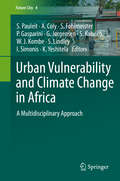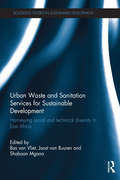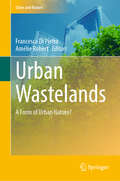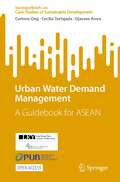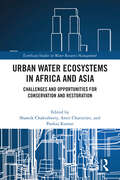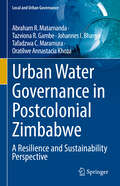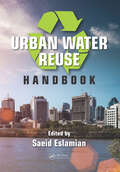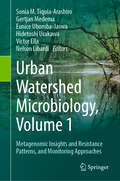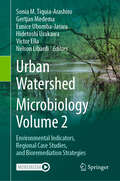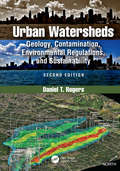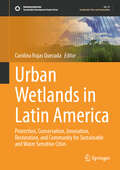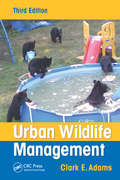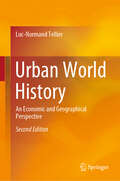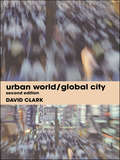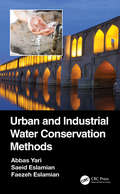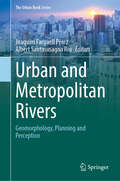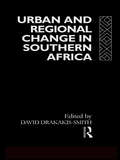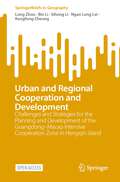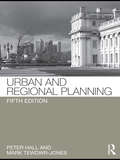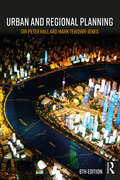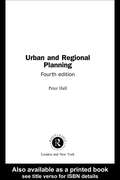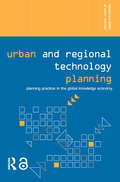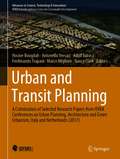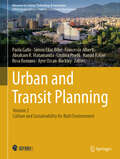- Table View
- List View
Urban Utopias: The Built and Social Architectures of Alternative Settlements
by Malcolm MilesUtopia tends to generate a bad press - regarded as impracticable, perhaps nostalgic, or contradictory when visions of a perfect world cannot accommodate the change that is necessary to a free and self-organizing society. But people from diverse backgrounds are currently building a new society within the old, balancing literal and metaphorical utopianism, and demonstrating plural possibilities for alternative futures and types of settlement. Thousands of such places exist around the world, including intentional communities, eco-villages, permaculture plots, religious and secular retreats, co-housing projects, self-build schemes, projects for low-impact housing, and activist squats in urban and rural sites. This experience suggests, however, that when planning and design are not integral to alternative social formations, the modern dream to engineer a new society cannot be realized. The book is structured in four parts. In part one, literary and theoretical utopias from the early modern period to the nineteenth-century are reconsidered. Part two investigates twentieth-century urban utopianism and contemporary alternative settlements focusing on social and environmental issues, activism and eco-village living. Part three looks to wider horizons in recent practices in the non-affluent world, and Part four reviews a range of cases from the author’s visits to specific sites. This is followed by a short conclusion in which a discussion of key issues is resumed. This book brings together insights from literary, theoretical and practical utopias, drawing out the characteristics of groups and places that are part of a new society. It links today’s utopian experiments to historical and literary utopias, and to theoretical problems in utopian thought.
Urban Vulnerability and Climate Change in Africa
by Paolo Gasparini Stephan Pauleit Adrien Coly Sandra Fohlmeister Gertrud Jørgensen Sigrun Kabisch Wilbard J. Kombe Sarah Lindley Ingo Simonis Kumelachew YeshitelaUrbanisation and climate change are among the major challenges for sustainable development in Africa. The overall aim of this book is to present innovative approaches to vulnerability analysis and for enhancing the resilience of African cities against climate change-induced risks. Locally adapted IPCC climate change scenarios, which also consider possible changes in urban population, have been developed. Innovative strategies to land use and spatial planning are proposed that seek synergies between the adaptation to climate change and the need to solve social problems. Furthermore, the book explores the role of governance in successfully coping with climate-induced risks in urban areas. The book is unique in that it combines: a top-down perspective of climate change modeling with a bottom-up perspective of vulnerability assessment; quantitative approaches from engineering sciences and qualitative approaches of the social sciences; a novel multi-risk modeling methodology; and strategic approaches to urban and green infrastructure planning with neighborhood perspectives of adaptation.
Urban Waste and Sanitation Services for Sustainable Development: Harnessing Social and Technical Diversity in East Africa (Routledge Studies in Sustainable Development)
by Bas Van Vliet Joost Van Buuren Shaaban MganaUrban sanitation and solid waste sectors are under significant pressure in East Africa due to the lack of competent institutional capacity and the growth of the region’s urban population. This book presents and applies an original analytical approach to assess the existing socio-technical mixtures of waste and sanitation systems and to ensure wider access, increase flexibility and ecological sustainability. It shows how the problem is not the current diversity in waste and sanitation infrastructures and services and variety of types and scales of technology, of formal and informal sector involvement, and of management and ownership modes. The book focuses instead on the lack of an integrative approach to managing and upgrading of the various waste and sanitation configurations and services so as to ensure wider access, flexibility and sustainability for the low income populations who happen to be the main stakeholders. This approach, coined "Modernized Mixtures", serves as a nexus throughout the book. The empirical core addresses the waste and sanitation challenges and debates at each scale - from the micro-level (households) to the macro-level (international support) - and is based on the results of a five-year-long interdisciplinary, empirical research program. It assesses the socio-technical diversity in waste and sanitation and provides viable solutions to sanitation and waste management in East Africa. This book provides students, researchers and professional in environmental technology, sociology, management and urban planning with an integrated analytical perspective on centralized and decentralized waste and sanitation configurations and tools for improvement in the technology, policy and management of sanitation and solid waste sectors.
Urban Wastelands: A Form of Urban Nature? (Cities and Nature)
by Francesca Di Pietro Amélie RobertFaced with the growing demand for nature in cities, informal greenspaces are gaining the interest of various stakeholders - residents, associations, public authorities - as well as scientists. This book provides a cross-sectorial overview of the advantages and disadvantages of urban wastelands in meeting this social demand of urban nature, spanning from the social sciences and urban planning to ecology and soil sciences. It shows the potential of urban wastelands with respect to city dwellers’ well-being, environmental education, urban biodiversity and urban green networks as well as concerns regarding urban wastelands’ in relation to conflicts, and urban marketing. The authors provide a global insight through case studies in nine countries, mainly located in Europe, Asia and America, thus offering a broad perspective.
Urban Water Demand Management: A Guidebook for ASEAN (SpringerBriefs on Case Studies of Sustainable Development)
by Cecilia Tortajada Corinne Ong Ojasvee AroraThis open access book highlights knowledge and expertise in Urban Water Demand Management (WDM) in ASEAN through comprehensive literature review and analysis, as well as stakeholder consultations. It documents urban WDM policies, initiatives, and practices that have demonstrated effective implementation outcomes across various contexts and which are expected to be relevant for cities in ASEAN. A WDM typology developed for this book identifies four key WDM measures, namely: water losses, economic instruments, non-price mechanisms, and alternative water reuse systems in the ASEAN context. Case illustrations of their effective implementation in different ASEAN cities are also included.
Urban Water Ecosystems in Africa and Asia: Challenges and Opportunities for Conservation and Restoration (Earthscan Studies in Water Resource Management)
by Amit Chatterjee Shamik Chakraborty Pankaj KumarThis book examines urban water ecosystem management and restoration through selected case studies in Asia and Africa. Employing a socioecological approach, this volume presents insights on the interlinkages between water, humans, and environmental conservation in an urban context.Topics include human health risks, population displacement and migration, water pollution, water scarcity, flood management, water infrastructure, afforestation, and the effects of climate change. Case studies are drawn from a variety of countries in Africa and Asia, including China, Japan, India, Vietnam, Bangladesh, Kenya, Malawi, and Tunisia, which demonstrate a wide range of different challenges, and opportunities. Overall, this book argues that to better manage urban water resources, there needs to be a shift from urban water management to urban water ecosystem management. This shift needs to acknowledge the complex biophysical and socio-political dimensions of water ecosystems.This book will be of great interest to students and scholars of water resource management, ecosystem services, urban studies, environmental conservation and sustainable development.
Urban Water Governance in Postcolonial Zimbabwe: A Resilience and Sustainability Perspective (Local and Urban Governance)
by Abraham R. Matamanda Tazviona R. Gambe Johannes I. Bhanye Tafadzwa C. Maramura Oratilwe Annastacia KhozaThis book focuses on urban water supply and governance in the Global South using urban Zimbabwe as a case study to provide insights and perspectives into the realities of the water governance. Applying a resilience and sustainability perspective, we argue that fragmentation of responsibilities between various institutions, the difficulty of coordination at various levels, and the politics centered on water supply constrain effective water governance in Zimbabwe. This has resulted in a downward spiral in urban water services in Zimbabwe's urban centers. Additionally, the innovative nature of this study is to draw from an often-neglected dimension in urban water governance, which is the political ecology which brings into perspective the varying int1erests associated with environmental contests and conflicts that influence water allocation and sharing among urban areas by the public sector. Therefore, this book dwells on understanding the politics, economic and ecology of water governance through an interdisciplinary lens. This analysis is critical for this study because Zimbabwe's current state of obsolete water infrastructure has also had a negative impact on the supply of high-quality portable water services to the public in urban areas. This book will be a critical read for academic and professionals in the fields of urban geographers, planners, sociologists and water experts. It will also be useful for undergraduate and postgraduate students from Geography, Urban and regional Planning, Political Science, Development Studies and Economics.
Urban Water Reuse Handbook
by Saeid EslamianExamining the current literature, research, and relevant case studies, presented by a team of international experts, the Urban Water Reuse Handbook discusses the pros and cons of water reuse and explores new and alternative methods for obtaining a sustainable water supply. The book defines water reuse guidelines, describes the historical and curren
Urban Watershed Microbiology, Volume 1: Metagenomic Insights and Resistance Patterns, and Monitoring Approaches
by Sonia M. Tiquia-Arashiro Gertjan Medema Eunice Ubomba-Jaswa Hidetoshi Urakawa Victor Ella Nelson LibardiThis book addresses significant gaps in our understanding of how watershed microbial structures and functions respond to the pressures of urbanization. It consolidates rapidly evolving, yet often fragmented, global data on watershed microbiomes, providing critical insights into the impacts of urban pollution, human health risks, and long-term ecological consequences. Featuring the latest technological advancements in biological monitoring, microbial source-tracking technologies, and strategies for effective watershed management, this volume serves as a comprehensive and reliable source for the current state of urban watershed microbiology. It examines the unique challenges urbanization presents to ecosystems, especially in terms of atmospheric chemistry, hydrology, vegetation, and how these factors disrupt microbial communities that mediate essential ecosystem services like water purification, nutrient recycling, and degradation of pollutants. Together the two-volume work delves into the mechanisms behind the urban watershed syndrome—ecological degradation of streams—and explores many unanswered questions that hinder progress in understanding urban watershed microbiomes. With original research articles, reviews, and perspectives, this collection is a key resource for microbiologists, environmental scientists, engineers, and professionals involved in water quality, ecosystem management, and land-use planning. The hope is that this volume will inspire new breakthroughs, drive further research, and ultimately help shape effective strategies for addressing the ecological challenges of urban watersheds.
Urban Watershed Microbiology, Volume 2: Environmental Indicators, Regional Case Studies, and Bioremediation Strategies
by Sonia M. Tiquia-Arashiro Gertjan Medema Eunice Ubomba-Jaswa Hidetoshi Urakawa Victor Ella Nelson LibardiThis book addresses significant gaps in our understanding of how watershed microbial structures and functions respond to the pressures of urbanization. It consolidates rapidly evolving, yet often fragmented, global data on watershed microbiomes, providing critical insights into the impacts of urban pollution, human health risks, and long-term ecological consequences. Featuring the latest technological advancements in biological monitoring, microbial source-tracking technologies, and strategies for effective watershed management, this volume serves as a comprehensive and reliable source for the current state of urban watershed microbiology. It examines the unique challenges urbanization presents to ecosystems, especially in terms of atmospheric chemistry, hydrology, vegetation, and how these factors disrupt microbial communities that mediate essential ecosystem services like water purification, nutrient recycling, and degradation of pollutants. Together this two-volume work delves into the mechanisms behind the urban watershed syndrome—ecological degradation of streams—and explores many unanswered questions that hinder progress in understanding urban watershed microbiomes. With original research articles, reviews, and perspectives, this collection is a key resource for microbiologists, environmental scientists, engineers, and professionals involved in water quality, ecosystem management, and land-use planning. The hope is that this volume will inspire new breakthroughs, drive further research, and ultimately help shape effective strategies for addressing the ecological challenges of urban watersheds.
Urban Watersheds: Geology, Contamination, Environmental Regulations, and Sustainability, Second Edition
by Daniel T. RogersUnderstanding that the natural world beneath our feet is the point at which civilization meets the natural world is critical to the success of restoration and prevention efforts to reduce contaminant impacts and improve the global environment because of one simple fact – contaminants do not respect country borders. Contaminants often begin their destructive journey immediately after being released and can affect the entire planet if the release is in just the right amount, at just the right location, and at just the right time. Taking an interdisciplinary approach, Urban Watersheds, Geology, Contamination, Environmental Regulations, and Sustainability, Second Edition presents more than 30 years of research and professional practice on urban watersheds from the fields of environmental geology, geochemistry, risk analysis, hydrology, and urban planning. The geological characteristics of urbanized watersheds along with the physical and chemical properties of their common contaminants are integrated to assess risk factors for soil, groundwater, and air. This new edition continues to examine the urban environment and the geology beneath urban areas, evaluates the contamination that affects watersheds in urban regions, and addresses redevelopment strategies. Features of the Second Edition: Examines contaminants and the successes of environmental regulation worldwide and highlights the areas that need improvement Describes several advances in investigation techniques in urban regions that now provide a huge leap forward in data collection, resolution, and accuracy Explains the importance of understanding the geological and hydrogeologic environments of urban and developed regions Provides new and enhanced methods presented as a sustainability model for assessing risks to human health and the environment from negative human-induced contaminant impacts Includes a new chapter that surveys how environmental regulations have been successful or have failed at protecting the air, water, and land in urban areas Suitable for use as a textbook and as a professional practice reference, the book includes case studies on successful and unsuccessful approaches to contaminant remediation as well as practical methods for environmental risk assessment. PowerPoint® presentations of selected portions of the book are available with qualifying course adoption. Daniel T. Rogers is currently the Director of Environmental Affairs at Amsted Industries Inc. in Chicago, Illinois. His writings address environmental geology, hydrogeology, geologic vulnerability and mapping, contaminant fate and transport, urban geology, environmental site investigations, contaminant risk, brownfield redevelopment, and sustainability. He has taught geology and environmental chemistry at Eastern Michigan University and the University of Michigan.
Urban Wetlands in Latin America: Protection, Conservation, Innovation, Restoration, and Community for Sustainable and Water Sensitive Cities (Sustainable Development Goals Series)
by Carolina Rojas QuezadaThis book is about the contribution of urban wetlands in livable cities. Urban wetlands are very valuable blue-green infrastructure spaces for human settlements, yet they are disappearing as a result of urbanization. This phenomenon is worldwide, but is particularly intense in Latin America. Although international literature has made an effort to document the multiple ecosystem services provided by these ecosystems, such as water and air cleansing, flood mitigation and recreation, among others, we want to draw attention to the fact that the loss of urban wetlands affects the sustainability of cities and future generations. Therefore, and given the weakness of public policies implemented in the region for their protection, it is essential to highlight good practices, mechanisms and strategies aimed at Protection, Conservation, Innovation, Restoration, and work with the Community, all of this hand in hand with the 17 Sustainable Development Goals. The book offers a comprehensive coverage combining the need to protect and conserve urban wetlands from the pressures of urban growth, as well as highlighting successful experiences of regulation and of course applied research aimed at nature-based solution design for flood management and wastewater treatment, restoration areas, green infrastructure plans, as well as experiences of collective work with communities in contexts of political tensions for the defense of wetlands.
Urban Wildlife Management
by Clark E. AdamsWinner of the 2018 TWS Wildlife Publication Awards in the authored book category Urban development is one of the leading worldwide threats to conserving biodiversity. In the near future, wildlife management in urban landscapes will be a prominent issue for wildlife professionals. This new edition of Urban Wildlife Management continues the work of its predecessors by providing a comprehensive examination of the issues that increase the need for urban wildlife management, exploring the changing dynamics of the field while giving historical perspectives and looking at current trends and future directions. The book examines a range of topics on human interactions with wildlife in urbanized environments. It focuses not only on ecological matters but also on political, economic, and societal issues that must be addressed for successful management planning. This edition features an entirely new section on urban wildlife species, including chapters on urban communities, herpetofauna, birds, ungulates, mammals, carnivores, and feral and introduced species. The third edition features Five new chapters 12 updated chapters Four new case studies Seven new appendices and species profiles 90 new figures A comprehensive analysis of terrestrial vertebrate locations by state and urban observations Each chapter opens with a set of key concepts which are then examined in the following discussions. Suggested learning experiences to enhance knowledge conclude each chapter. The species profiles cover not only data about the animal concerned but also detail significant current management issues related to the species. An updated and expanded teaching tool, Urban Wildlife Management, Third Edition identifies the challenges and opportunities facing wildlife in urban communities as well as factors that promote or threaten their presence. It gives both students and professionals a solid grounding in the required fundamental ecological principles for understanding the effects of human-made environments on wildlife.
Urban World History: An Economic and Geographical Perspective
by Luc-Normand TellierThis book seeks to deepen readers’ understanding of world history by investigating urbanization and the evolution of urban systems, as well as the urban world, from the perspective of historical analysis. The theoretical framework of the approach stems directly from space-economy, and, more generally, from location theory and the theory of urban systems.The author explores a certain logic to be found in world history, and argues that this logic is spatial (in terms of spatial inertia, spatial trends, attractive and repulsive forces, vector fields, etc.) rather than geographical (in terms of climate, precipitation, hydrography). Accordingly, the book puts forward a truly original vision of urban world history, one that will benefit economists, historians, regional scientists, and anyone with a healthy curiosity.
Urban World/Global City
by David ClarkThis book identifies and accounts for the characteristics of the contemporary city and of urban society. It analyzes the distribution and growth of settlements and explores the social and behavioral characteristics of urban living. The latest theoretical and empirical developments and insights are synthesized and presented in an accessible and engaging way.This second edition has been extensively updated and referenced. Each chapter includes sets of learning objectives, annotated readings and topics for discussion. Well-illustrated throughout, it will be essential reading for students of geography, sociology and development studies and all who seek an understanding of how the urban world has evolved and how it will change in the twenty-first century.
Urban and Industrial Water Conservation Methods
by Saeid Eslamian Faezeh Eslamian Abbas YariUrban and Industrial Water Conservation Methods provides comprehensive and practical information regarding water use for various different sectors and describes the most suitable conservation devices and techniques to reduce water consumption in urban environments. It demonstrates how these conservation devices and best practices can greatly and quickly increase the efficiency of water use in both new and existing buildings. Features: Examines conservation devices and techniques across residential, commercial, and institutional sectors. Provides practical advice on implementing water conservation methods for users across various industries. Explains how to quickly improve water efficiency by using cost-effective water-saving devices and techniques. Includes relevant international case studies to reinforce the content. Written by practicing water conservation consultants for a wide audience, including municipality authorities and decision-makers, researchers, and students alike, Urban and Industrial Water Conservation Methods applies to residential, commercial, institutional, and industrial end users.
Urban and Metropolitan Rivers: Geomorphology, Planning and Perception (The Urban Book Series)
by Joaquim Farguell Pérez Albert Santasusagna RiuThis book provides a detailed description of fluvial processes and their influence on urban sites. During the urban expansion of modern cities throughout the twentieth century, rivers have become a source of problems during high flood events. However, due to growing social pressure, especially in dense cities, rivers are viewed as new leisure areas given that they also provide highly valuable ecosystem services. People seek open and environmentally friendly spaces amidst the dense street networks of cities. Yet, we should not forget that rivers are not merely domesticated elements of nature for leisure purposes only. Flooding risks and damages are possible within urban environments. How should we address the social and ecological interactions? How should we plan for these complexities to meet the growing social requirements and needs while respecting river dynamics? Hydrologists, geomorphologists, engineers, geographers and urban planners could leverage the knowledge and examples provided to enhance the interaction between nature and society in the growing cities of the twenty-first century.
Urban and Regional Change in Southern Africa
by David Drakakis-SmithFirst Published in 2004. Routledge is an imprint of Taylor & Francis, an informa company.
Urban and Regional Cooperation and Development: Challenges and Strategies for the Planning and Development of the Guangdong–Macao Intensive Cooperation Zone in Hengqin Island (SpringerBriefs in Geography)
by Bin Li Long Zhou Sihong Li Ngan Leng Lei Kengfong CheongThis is an open access book. This book, first of all, introduces the new unveiled Guangdong-Macao Intensive Cooperation Zone with details as a special mode of the regional collaborative development that is committed to be mutually beneficial to both sides with different political and economic systems. China's central authorities have recently issued a masterplan for constructing the Guangdong-Macao Intensive Cooperation Zone at Hengqin Island in September 2021. As China's first and last European colony and one of China’s two special administrative regions (SARs), Macao has developed the gambling industry seven times larger than that of Las Vegas. However, the problem of the homogeneous industrial structure and the urgent need to promote sustainable economic growth by regional cooperation have been important theoretical and practical issues discussed by scholars and policy-makers. The Guangdong-Macao Intensive Cooperation Zone (ICZ) is managed under special customs supervision between two boarder lines and expected to diversify Macao’s economy. Then, this book dissects the theory of regional synergistic development and its applications in a number of international comparative and cross-interdisciplinary case studies worldwide. Finally, from the perspective of land use, transportation connection, and social service, this book thoroughly explores the challenges and strategies to implement the new cooperation model within the framework of one country, two systems, two customs, and two currencies to achieve a win–win situation using updated first-hand data collected by literature review, case study, field survey, spatial analysis, and interview.
Urban and Regional Planning
by Peter Hall Mark Tewdwr-JonesThis is the fifth edition of the classic text for students of urban and regional planning. It gives an historical overview of the developments and changes in the theory and practice of planning, throughout the entire twentieth century. This extensively revised edition follows the successful format of previous editions: it introduces the establishment of planning as part of the public health reforms of the late nineteenth century and goes on to look at the insights of the great figures who influenced the early planning movement, leading up to the creation of the post-war planning machine national and regional planning, and planning for cities and city regions, in the UK, from 1945 to 2010, is then considered. Specific reference is made to the most important British developments in recent times, including the Single Regeneration Budget, English Partnerships, the devolution of Scotland, Wales and Northern Ireland, the establishment of the Mayor of London and the dominant urban sustainability paradigm planning in Western Europe, since 1945, now incorporating new material on EU-wide issues, as well as updated country specific sections planning in the United States, since 1945, now discussing the continuing trends of urban dispersal and social polarisation, as well as initiatives in land use planning and transportation policies finally the book looks at the nature of the planning process at the start of the twenty-first century, reflecting briefly on shifts in planning paradigms since the 1960s and going on to discuss the main issues of the 1990s and 2000s, including sustainability and social exclusion and looking forward to the twenty-first century.
Urban and Regional Planning
by Peter Hall Mark Tewdwr-JonesThis is the sixth edition of the classic text for students of urban and regional planning. It gives a historical overview of the developments and changes in the theory and practice of planning throughout the entire 20th and first part of the 21st centuries. The extensively revised edition incorporates the most important developments in recent times: debates on economic rebalancing and national infrastructure including high speed rail, energy, millennium projects, Celtic devolution, European influence, impact of London on nation. A new chapter "Planning for cities and city regions 1990-2017": includes new material on housing, localism, neighbourhood planning, privatisation, city modernism, reform, Devo and city deals and metro mayors. Urban and Regional Planning will be invaluable to undergraduate as well as postgraduate Planning students. It will prove useful in a variety of built environment areas such as Architecture, Landscape Architecture, Urban Design, Real Estate where planning is taught.
Urban and Regional Planning
by Peter HallThis is the fourth edition of the classic text for students of urban and regional planning. It gives a historical overview of the developments and changes in the theory and practice of planning, throughout the entiretwentieth century.This extensively revised edition follows the successful format of previous editions. Specific reference is made to the most important British developments in recent times, including the devolution of Scotland, Wales and Northern Ireland, the establishment of the Mayor of London and the dominant urban sustainability paradigm.Planning in Western Europe, since 1945, now incorporates new material on EU-wide issues as well as updated country specific sections. Planning in the United States since 1945, now discusses the continuing trends of urban dispersal and social polarisation, as well as initiatives in land use planning and transportation policies.The book looks at the nature of the planning process at the end of the twentieth century and looks forward to the twenty-first century.
Urban and Regional Technology Planning: Planning Practice in the Global Knowledge Economy (Networked Cities Series)
by Mark Wilson Kenneth E. CoreyPart of the popular Networked Cities series, Urban and Regional Technology Planning focuses on the practice of relational planning and the stimulation of local city-regional scale development planning in the context of the global knowledge economy and network society. Designed to offer scholars, practitioners, and decision makers studies on the ways of cities, technologies, and multiple forms of urban movement intersect and create the contemporary urban environment, Kenneth Corey and Mark Wilson explore the dynamics of technology-induced change that is taking place within the context of the global knowledge economy and network society. Examining first the knowledge economy itself, Wilson and Corey go on to discuss its implications before proposing ways to strategize for future intelligent development, with particular emphasis on the ALERT model for regional and local planning. An important read for those practicing or studying planning in this network society.
Urban and Transit Planning: A Culmination of Selected Research Papers from IEREK Conferences on Urban Planning, Architecture and Green Urbanism, Italy and Netherlands (2017) (Advances in Science, Technology & Innovation)
by Nancy Clark Hocine Bougdah Antonella Versaci Adolf Sotoca Ferdinando Trapani Marco MiglioreA volume of five parts, this book is a culmination of selected research papers from the second version of the international conferences on Urban Planning & Architectural Design for sustainable Development (UPADSD) and Urban Transit and Sustainable Networks (UTSN) of 2017 in Palermo and the first of the Resilient and Responsible Architecture and Urbanism Conference (RRAU) of 2018 in the Netherlands. This book, not only discusses environmental challenges of the world today, but also informs the reader of the new technologies, tools, and approaches used today for successful planning and development as well as new and upcoming ones. Chapters of this book provide in-depth debates on fields of environmental planning and management, transportation planning, renewable energy generation and sustainable urban land use. It addresses long-term issues as well as short-term issues of land use and transportation in different parts of the world in hopes of improving the quality of life. Topics within this book include: (1) Sustainability and the Built Environment (2) Urban and Environmental Planning (3) Sustainable Urban Land Use and Transportation (4) Energy Efficient Urban Areas & Renewable Energy Generation (5) Quality of Life & Environmental Management Systems. This book is a useful source for academics, researchers and practitioners seeking pioneering research in the field.
Urban and Transit Planning: Volume 2: Culture and Sustainability for Built Environment (Advances in Science, Technology & Innovation)
by Simon Elias Bibri Francesco Alberti Abraham R. Matamanda Paola Gallo Cristina Piselli Hamid Rabiei Rosa Romano Ayse Ozcan-BuckleyThis book covers a critical topic, including green building design, sustainable urban mobility, renewable energy integration, and the use of advanced technologies to minimize environmental impact. Through comprehensive analysis and practical case studies, it highlights how thoughtful design and planning can transform urban areas into resilient, eco-friendly spaces. Also, it explores the challenges and opportunities associated with implementing sustainable practices in urban planning and architectural design. It highlights successful projects from around the world, demonstrating innovative solutions that address issues. Aimed at professionals, researchers, and students, this book provides valuable insights and actionable strategies for fostering sustainable growth. It serves as an essential guide for anyone committed to creating cities and buildings that not only meet the needs of the present but also safeguard the well-being of future generations. Through its comprehensive coverage and forward-thinking approach, it inspires a new era of urban transformation focused on sustainability and resilience.

